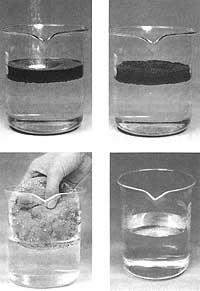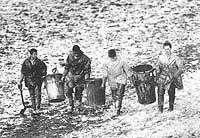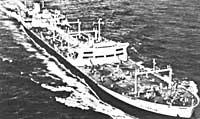Surprising absorbers clean the sea
1988/06/01 Aizpurua Sarasola, Joxerra Iturria: Elhuyar aldizkaria

Just a year ago, the presenter of a technological innovation program on Japanese television poured the oil that was on a ship on his table. Then he took out a white powder and threw it over the oil. Ten seconds after the presenter reached the table, no oil or dust remains.
As you can imagine, the public was completely surprised; where is the oil? It seemed like a miracle! But the spectators were before the best carpenter I had ever seen. When the absorber acts on the hydrocarbon two different phases can be distinguished. In the first phase the absorbent powder absorbs oil like a sponge. That is not uncommon, because clays, for example, have the same property.
The second, for its part, presents a remarkable singularity. The powder bloated by absorption is solidified. After the plastification of each molecule, oil is hermetically trapped. A rubber layer is obtained. It is very consistent and easy to recover. But what has been the origin of this product?
The miracle began when in 1975 researchers from the French company CdF Chimie investigated several compounds and discovered that the substance called polybornene had absorbent properties. When awareness emerged that the incidence of this substance could be important in the fight against pollution, a market study was conducted. As a result of this study, two obstacles occurred. On the one hand the price, i.e. the kilo of the polybornene 125 sts. Its value was between 6 and 7 times above conventional products. On the other hand, since the product was an organic tissue, it was not convenient to store more than thirty months, since it ran the risk of losing properties.
It was decided to rule out product development for these reasons. Anti-pollution legislation was hardened elsewhere.
One of them is Japan and the company Nippon Zeon began to be interested in this French product in 1982. A year later the product began to be marketed with the names Fixol and TFN-2. According to some studies, there was a high risk of accidents in the Southeast seas, so the main Japanese ports were equipped with Polyborns.
The winds in the sea make it very easy to disperse the dust. Then it is the fishermen who put an end to the work using their nets.

Seeing the success of polybornene, it has been chosen to extend it to other applications, both domestic and industrial.
In recent years the United States is also tightening anti-pollution legislation. However, one of the most pressing problems here is the thermal insulation of transformers. So far pyalenes have been used as insulators, but leaks and spills of this substance have contaminated more than 20,000 rafts. It seems that polybornene can be interesting as a substitute for piralenes and marketing is currently being studied.
Legislation on pollution problems is also tightening in Europe and this product or similar products will become increasingly important. However, the main trend of use of these substances is not only the fight against black tides, but the fight against industrial pollution. Researchers believe that the role they can play against radioactive waste in this area can be interesting. Therefore, this product may have future.
But now we have the opportunity to keep our Earth cleaner. Just take the opportunity.

Gai honi buruzko eduki gehiago
Elhuyarrek garatutako teknologia




